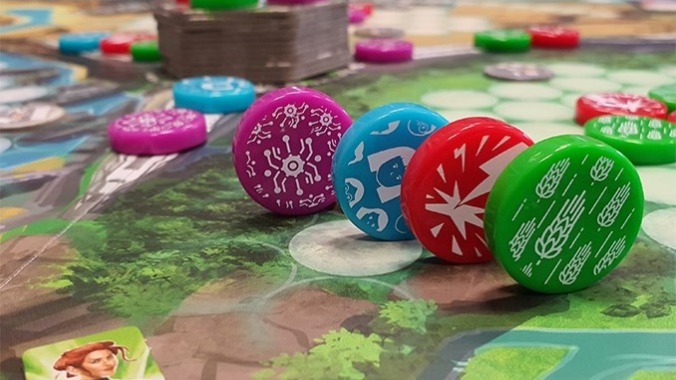Neotopia Is a Mash-up of Mechanics Done Better in Other Board Games

Neotopia is an easy-to-learn, abstract game of laying tiles to match patterns on your hand cards, but it doesn’t bring anything new to the table, and ends up as a light game of glorified solitaire. I found it mildly engaging, but it reminded me too much of other games that have similar mechanics or concepts but execute them in better ways.
Neotopia has a flimsy theme of players trying to build a new city in the distant future on earth, but it’s really quite disconnected from the game play itself—you don’t need to read any of the text describing the theme to understand the game on any level. There are tokens in four colors, matching the four possible player colors, that you’ll place on the board in any of the three ‘city’ regions. In between any two regions is a ‘factory’ that can contain up to four tokens, the colors of which will vary over the game, and that can only be moved into an adjacent region. Each player starts the game with three hand cards showing patterns of tokens that, once matched on the board, are worth 2 to 5 points. You also score points at game-end for the largest contiguous cluster of tokens in your color in each of the three cities.
There are two possible actions to take in Neotopia, and on your turn, you take three actions in total, in any combination you like. One is to take a pattern card, either taking one from the four face-up options or to take the face-down card on top of the deck. The other is to move a token from a factory into either of the two adjacent regions. You can take a token from either neighboring factory, and must place it either next to any token already in the region or, if the region is empty, on the center space. (This can only happen in a two-player game.) If placing a token completes a pattern that matches any of your cards, you score the card immediately as a free action. You can only score a card by placing a token, though—you can’t score for a pattern that’s already there, or that someone else completed, eliminating the quirk in many games (like Ticket to Ride) where you can draw a card and get its points for ‘free.’ When you score a pattern, you gain points on that region’s scoring track, so you will get three separate region scores in the game.

There are also bonus tokens you can claim during the game that give you some kind of extra action. Each region has four bonus tokens located on the perimeter that a player can claim with a legal token placement on each space. Each region’s scoring track has highlighted spaces at 7, 11, and 16 points, and once your scoring token reaches or crosses each of these spaces, you may take a bonus token from the stack if any remain. Bonus tokens can let you draw two cards as a free action, or place a token from any factory or the supply onto the board, or take a free fourth action on a turn. You may only use one bonus token per turn.
The scoring is by far the most interesting part of Neotopia, as it pushes for balance across all three regions. For each region, you add the number of tokens in the largest cluster of your color in that region to your previous total from scored cards. Then you compare your scores in each region: The two highest numbers score as is, while you get triple points for the region with your lowest score. You also get three points for each unused bonus token. The push for balance across the regions—a scoring concept that will always remind me of Tigris & Euphrates, which was either the first to use this conceit or just the first to popularize it—and the scoring for clusters both push players to think more globally than locally on the board.
That said, there’s nothing new in Neotopia. Every mechanic here is something we’ve seen before. The pattern-matching aspect is extremely common—there’s a heavy dose of Cascadia and Reef in that part of the game, while the board’s overall setup is reminiscent of Noctiluca, an underappreciated gem from Shem Phillips, better known for his heavier worker-placement games in the North Sea and West Kingdom trilogies. There’s also no player interaction; you can inadvertently block an opponent from completing a pattern, but unless you’re memorizing what cards your opponents take, you’ll never do this on purpose—and it’s probably self-defeating to do so anyway. It’s very easy to teach, and until the scoring it’s very easy to follow, enough that my 7-year-old had no trouble picking up the game or figuring out a strategy, including the need to balance out her efforts across the three regions. If it weren’t for that novel scoring bit, I wouldn’t recommend Neotopia; instead it’s a nice filler if you’ve played games of this ilk and want a little change of pace, but nothing I’d rush out to get.
Keith Law is the author of The Inside Game and Smart Baseball and a senior baseball writer for The Athletic. You can find his personal blog the dish, covering games, literature, and more, at meadowparty.com/blog.